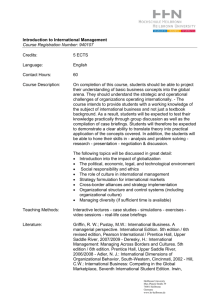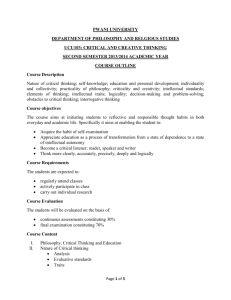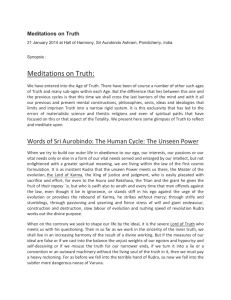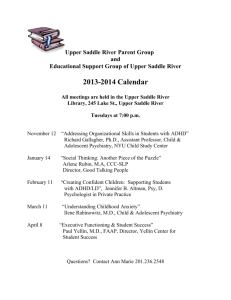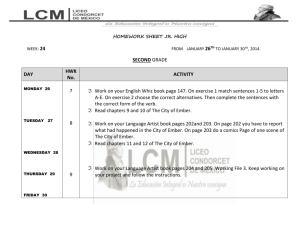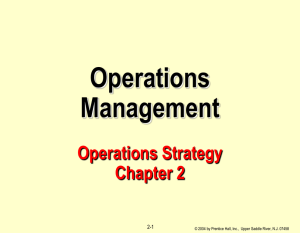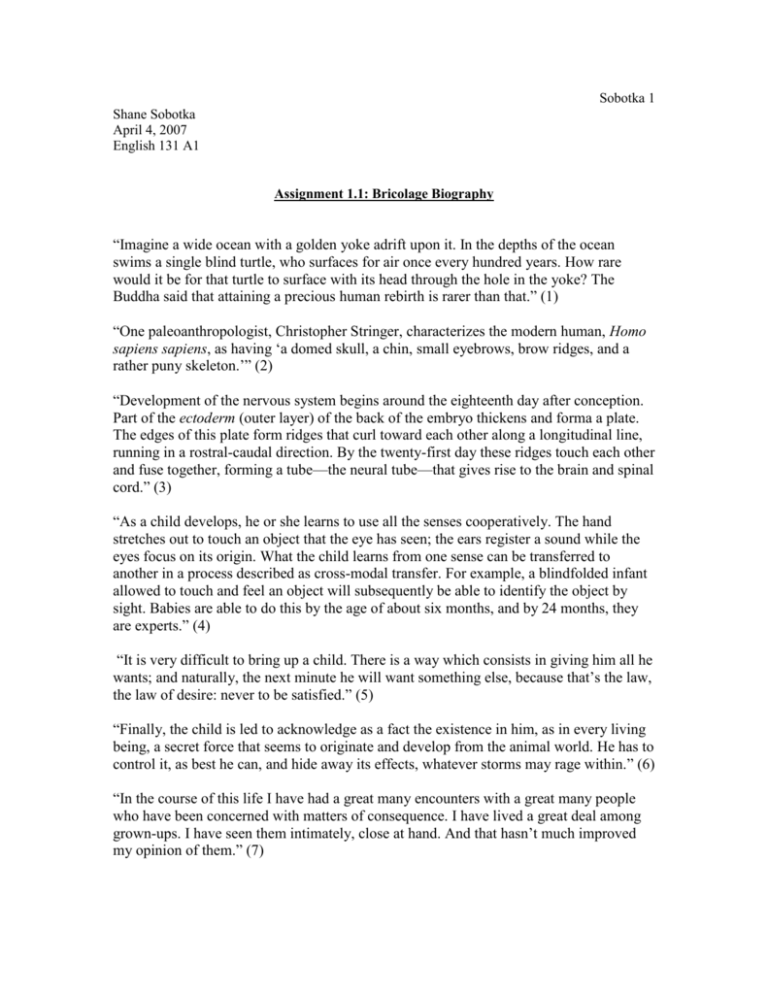
Sobotka 1
Shane Sobotka
April 4, 2007
English 131 A1
Assignment 1.1: Bricolage Biography
“Imagine a wide ocean with a golden yoke adrift upon it. In the depths of the ocean
swims a single blind turtle, who surfaces for air once every hundred years. How rare
would it be for that turtle to surface with its head through the hole in the yoke? The
Buddha said that attaining a precious human rebirth is rarer than that.” (1)
“One paleoanthropologist, Christopher Stringer, characterizes the modern human, Homo
sapiens sapiens, as having ‘a domed skull, a chin, small eyebrows, brow ridges, and a
rather puny skeleton.’” (2)
“Development of the nervous system begins around the eighteenth day after conception.
Part of the ectoderm (outer layer) of the back of the embryo thickens and forma a plate.
The edges of this plate form ridges that curl toward each other along a longitudinal line,
running in a rostral-caudal direction. By the twenty-first day these ridges touch each other
and fuse together, forming a tube—the neural tube—that gives rise to the brain and spinal
cord.” (3)
“As a child develops, he or she learns to use all the senses cooperatively. The hand
stretches out to touch an object that the eye has seen; the ears register a sound while the
eyes focus on its origin. What the child learns from one sense can be transferred to
another in a process described as cross-modal transfer. For example, a blindfolded infant
allowed to touch and feel an object will subsequently be able to identify the object by
sight. Babies are able to do this by the age of about six months, and by 24 months, they
are experts.” (4)
“It is very difficult to bring up a child. There is a way which consists in giving him all he
wants; and naturally, the next minute he will want something else, because that’s the law,
the law of desire: never to be satisfied.” (5)
“Finally, the child is led to acknowledge as a fact the existence in him, as in every living
being, a secret force that seems to originate and develop from the animal world. He has to
control it, as best he can, and hide away its effects, whatever storms may rage within.” (6)
“In the course of this life I have had a great many encounters with a great many people
who have been concerned with matters of consequence. I have lived a great deal among
grown-ups. I have seen them intimately, close at hand. And that hasn’t much improved
my opinion of them.” (7)
“Unstated is that the responsible men gain that status not by virtue of any special talent or
knowledge but by willing subordination to the systems of actual power and loyalty to
their operative principles—crucially, that basic decisions over social and economic life
are to be kept within institutions with top-down authoritarian control, while the
participation of the beast is to be limited to a diminished public arena.” (8)
“This planet has—or rather had—a problem, which was this: most of the people living
on it were unhappy for pretty much of the time. Many solutions were suggested for this
problem, but most of these were largely concerned with the movements of small green
pieces of paper, which is odd because on the whole it wasn’t the small green pieces of
paper that were unhappy.” (9)
“This may be said for the last quarter of the twentieth century: the truism that if we want
a better world we will have to be better people came to be acknowledged, if not
thoroughly understood, by a significantly large minority.” (10)
“O bliss of understanding, greater than the bliss of imagining or feeling.” (11)
“On those occasions, if you take the example of a positive feeling, we might say that the
mind represents more than well-being. The mind also represents well-thinking. The flesh
operates harmoniously, or so the mind says, and our thinking powers are either at the top
of their game or can be taken there. Likewise, feeling sad is not just about a sickness in
the body or about a lack of energy to continue. It is often about an inefficient mode of
thought stalling around a limited number of ideas of loss” (12)
“But I am a great believer in saying familiar, well-known things backwards and insideout, hoping that from some new vantage point the old facts will take on a deeper
significance.” (13)
“They were people like us, facing problems broadly similar to those that we now face.
They were prone to either succeed or fail, depending on circumstances similar to those
making us prone to succeed or fail today. Yes, there are differences between the situation
we face today and that faced by past peoples, but there are still enough similarities for us
to be able to learn from the past” (14)
“Our increasingly technological society requires citizens who have been educated in
basic science process and biology, because these serve as a basis for making rational
decisions in many critical areas. Increasing the level of scientific literacy among college
students is certainly one of the most important instructional contributions we make, but
achieving a high level of student involvement can be a challenge.” (15)
“While I am responsible for the use I made of the information that I received, it was
impossible to complete this undertaking on my own.” (16)
“The industrial products and processes that are being designed and developed today will
dictate a large fraction of the industry-environment interactions over the next decade and
longer. Thus, process and product design engineers hold much of the future of industryenvironment interactions in their hands, and nearly all are favorably disposed toward
designing with the environment in mind.” (17)
“In other words, I came of age when Americans were slowly coming to see themselves
not as separate from, but as part of, a living planet.” (18)
1) The Dali Lama. The Way to Freedom. New York: HarperCollins Publishers,
1994.
2) Ember, Carol; Ember, Melvin; Peregrine, Peter. Anthropology - 11th ed. Upper
Saddle River, New Jersey: Pearson Prentice Hall, 2005
3) Carlson, Neil. Foundations of Physiological Psychology – 5th ed. Boston: Allyn
and Bacon, 2002.
4) Cohen, David. The Secret Language of the Mind. San Francisco: Duncan Baird
Publishers, 1996.
5) The Mother. The Sunlit Path. Pondicherry, India: Sri Aurobindo Ashram
Publication Department, 1984.
6) Sri Aurobino; The Mother. On Love. Pondicherry, India: Sri Aurobindo Ashram
Publication Department, 1988.
7) De Saint Exupery, Antoine. The Little Prince. New York: Harcourt Brace and
World, 1971.
8) Chomsky, Noam. Hegemony or Survival: America’s Quest for Global
Dominance. New York: Henry Holt & Co., 2003.
9) Adams, Douglas. The Ultimate Hitchhiker’s Guide to the Galaxy. New York:
Ballantine Books, 2002.
10) Robbins, Tom. Still Life with Woodpecker. London: No Exit Press, 2001.
11) Borges, Jorge Luis. Labrynths: Selected Stories & Other Writings. New York:
New Directions Publishing, 1964.
12) Damasio, Antonio. Looking for Spinoza: Joy, Sorrow, and the Feeling Brain.
Orlando: Harcourt Inc., 2003.
13) Bonner, J.T. The Evolution of Development. Cambridge: Cambridge UP, 1958.
[as cited in: Dawkins, Richard. The Extended Phenotype: The Long Reach of the
Gene. Oxford: Oxford UP, 1999.]
14) Diamond, Jared. Collapse: How Societies Choose to Fail or Succeed. New York:
Viking Penguin, 2005.
15) Graham, Linda; Graham, James; Wilcox, Lee. Plant Biology – 2nd ed. Upper
Saddle River, New Jersey: Pearson Prentice Hall, 2006.
16) Lesko, Jim. Industrial Design: Materials and Manufacturing Guide. New York:
John Wiley & Sons, 1999.
17) Gradel, T.E.; Allenby, B.R. Design for Environment. Upper Saddle River, New
Jersey: Pearson Prentice Hall, 1998.
18) Uhl, Christopher. Developing Ecological Consciousness: Path to a Sustainable
World. New York: Rowman & Littlefield, 2004.
Shane,
In terms of effecting a narrative arc to make the bricolage cohere, this piece works
extremely well. The description of childhood development is executed in the discourses
of both science and affect or emotion. This strategy works quite well on many levels: the
discourses are folded nicely together such that the science register doesn’t overwhelm the
reader; the excerpts create a progression between themselves; and the scientific register is
matched by the occupational interest in science that emerges more fully towards the end
of the piece.
There’s a lovely trajectory that the biography builds, from an affect expressed through
childhood experience (biologic and emotional) to a comment on career goals in terms of
motivation and the kind of entry you plan to make into the world. Very good work.

